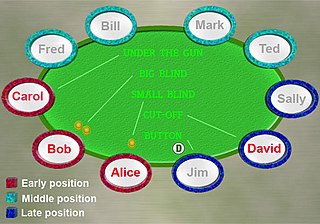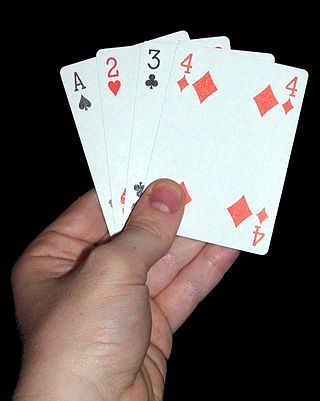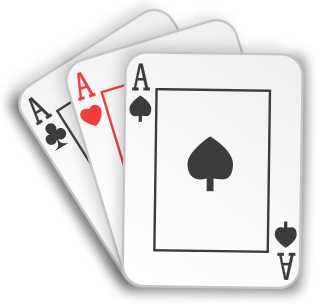
Poker is a family of comparing card games in which players wager over which hand is best according to that specific game's rules. It is played worldwide, but in some places the rules may vary. While the earliest known form of the game was played with just 20 cards, today it is usually played with a standard 52-card deck, although in countries where short packs are common, it may be played with 32, 40 or 48 cards. Thus poker games vary in deck configuration, the number of cards in play, the number dealt face up or face down and the number shared by all players, but all have rules that involve one or more rounds of betting.
A check-raise in poker is a common deceptive play in which a player checks early in a betting round, hoping someone else will open. The player who checked then raises in the same round.
In poker, pot odds are the ratio of the current size of the pot to the cost of a contemplated call. Pot odds are compared to the odds of winning a hand with a future card in order to estimate the call's expected value. The purpose of this is to statistically guide a player's decision between the options of call or fold. Raising is an alternative to place this decision on the opponent.
In game theory, the Nash equilibrium is the most commonly-used solution concept for non-cooperative games. A Nash equilibrium is a situation where no player could gain by changing their own strategy. The idea of Nash equilibrium dates back to the time of Cournot, who in 1838 applied it to his model of competition in an oligopoly.

In the card game of poker, a bluff is a bet or raise made with a hand which is not thought to be the best hand. To bluff is to make such a bet. The objective of a bluff is to induce a fold by at least one opponent who holds a better hand. The size and frequency of a bluff determines its profitability to the bluffer. By extension, the phrase "calling somebody's bluff" is often used outside the context of poker to describe situations where one person demands that another proves a claim, or proves that they are not being deceptive.

In the game of poker, the play largely centers on the act of betting, and as such, a protocol has been developed to speed up play, lessen confusion, and increase security while playing. Different games are played using different types of bets, and small variations in etiquette exist between cardrooms, but for the most part the following rules and protocol are observed by the majority of poker players.

Texas hold 'em is the most popular variant of the card game of poker. Two cards, known as hole cards, are dealt face down to each player, and then five community cards are dealt face up in three stages. The stages consist of a series of three cards, later an additional single card, and a final card. Each player seeks the best five-card poker hand from any combination of the seven cards: the five community cards and their two hole cards. Players have betting options to check, call, raise, or fold. Rounds of betting take place before the flop is dealt and after each subsequent deal. The player who has the best hand and has not folded by the end of all betting rounds wins all of the money bet for the hand, known as the pot. In certain situations, a "split pot" or "tie" can occur when two players have hands of equivalent value. This is also called "chop the pot". Texas hold 'em is also the H game featured in HORSE and HOSE.
The following outline is provided as an overview of and topical guide to poker:
In game theory, a Perfect Bayesian Equilibrium (PBE) is a solution with Bayesian probability to a turn-based game with incomplete information. More specifically, it is an equilibrium concept that uses Bayesian updating to describe player behavior in dynamic games with incomplete information. Perfect Bayesian equilibria are used to solve the outcome of games where players take turns but are unsure of the "type" of their opponent, which occurs when players don't know their opponent's preference between individual moves. A classic example of a dynamic game with types is a war game where the player is unsure whether their opponent is a risk-taking "hawk" type or a pacifistic "dove" type. Perfect Bayesian Equilibria are a refinement of Bayesian Nash equilibrium (BNE), which is a solution concept with Bayesian probability for non-turn-based games.
Morton's theorem is a poker principle articulated by Andy Morton in a Usenet poker newsgroup. It states that in multi-way pots, a player's expectation may be maximized by an opponent making a correct decision.
In game theory, trembling hand perfect equilibrium is a type of refinement of a Nash equilibrium that was first proposed by Reinhard Selten. A trembling hand perfect equilibrium is an equilibrium that takes the possibility of off-the-equilibrium play into account by assuming that the players, through a "slip of the hand" or tremble, may choose unintended strategies, albeit with negligible probability.

Badugi is a draw poker variant similar to triple draw, with hand-values similar to lowball. The betting structure and overall play of the game is identical to a standard poker game using blinds, but, unlike traditional poker which involves a minimum of five cards, players' hands contain only four cards at any one time. During each of three drawing rounds, players can trade zero to four cards from their hands for new ones from the deck, in an attempt to form the best badugi hand and win the pot. Badugi is often a gambling game, with the object being to win money in the form of pots. The winner of the pot is the person with the best badugi hand at the conclusion of play. Badugi is played in cardrooms around the world, as well as online, in rooms such as PokerStars. Although it hasn’t had its own tournament per se at the WSOP, it is featured in the Dealers Choice events as well as in the Triple Draw Mix. The 2023 WSOP event does have a Badugi tournament scheduled.
In game theory, a correlated equilibrium is a solution concept that is more general than the well known Nash equilibrium. It was first discussed by mathematician Robert Aumann in 1974. The idea is that each player chooses their action according to their private observation of the value of the same public signal. A strategy assigns an action to every possible observation a player can make. If no player would want to deviate from their strategy, the distribution from which the signals are drawn is called a correlated equilibrium.

Teen patti is a gambling card game. Teen Patti originated in India and is popular throughout South Asia. It originated in the English game of three-card brag, with influences from poker. It is also called flush or flash in some areas.
In game theory, an epsilon-equilibrium, or near-Nash equilibrium, is a strategy profile that approximately satisfies the condition of Nash equilibrium. In a Nash equilibrium, no player has an incentive to change his behavior. In an approximate Nash equilibrium, this requirement is weakened to allow the possibility that a player may have a small incentive to do something different. This may still be considered an adequate solution concept, assuming for example status quo bias. This solution concept may be preferred to Nash equilibrium due to being easier to compute, or alternatively due to the possibility that in games of more than 2 players, the probabilities involved in an exact Nash equilibrium need not be rational numbers.
The following is a glossary of poker terms used in the card game of poker. It supplements the glossary of card game terms. Besides the terms listed here, there are thousands of common and uncommon poker slang terms. This is not intended to be a formal dictionary; precise usage details and multiple closely related senses are omitted here in favor of concise treatment of the basics.
Baduci is a combination of Badugi poker and deuce to seven triple draw, and uses hand values similar to lowball. The pot in this game is split much like high-low split between the best Badugi hand and the best 2-7 triple draw hand. The betting structure and overall play of the game is nearly identical to a standard poker game using blinds. A players' hand contains five cards, where only four cards are used to determine the best Badugi hand and five cards are used to determine the triple draw hand. During each of three drawing rounds, players can trade zero to five cards from their hands for new ones from the deck.
Poker is a popular card game that combines elements of chance and strategy. There are various styles of poker, all of which share an objective of presenting the least probable or highest-scoring hand. A poker hand is usually a configuration of five cards depending on the variant, either held entirely by a player or drawn partly from a number of shared, community cards. Players bet on their hands in a number of rounds as cards are drawn, employing various mathematical and intuitive strategies in an attempt to better opponents.
Draw poker is any poker variant in which each player is dealt a complete hand before the first betting round, and then develops the hand for later rounds by replacing, or "drawing", cards.











